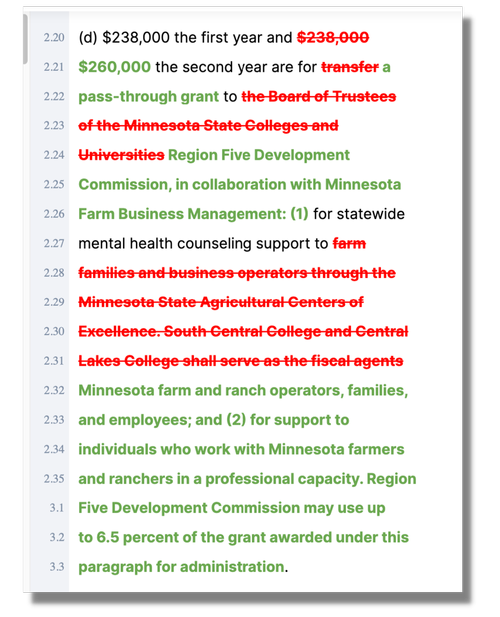Running a successful organization takes funding. Lots of funding.
Whether your organization is working to advance vital community projects, disrupt the tech industry, or establish itself as an education leader, money from grants is a critical ingredient in the recipe for success.
To find that all-important funding, organizations spend lots of time manually searching and applying for grants. But looking through numerous websites or relying on word of mouth is inefficient and time-consuming.
Today’s legislation tracking tools can streamline your entire search. For starters, you’ll never miss important updates, like changes to application deadlines and grant qualification criteria. You can automate reminders that will let you know when any changes occur on a bill related to a grant program you’re interested in.
Even better, this tech-driven approach will expand your access to new opportunities and improve your overall grant win percentage. Here’s what you need to know to begin using technology to help bring in more funding.
Make Your Grant Discovery and Management More Strategic
The beauty of today’s advanced technology is that if you find the right tool, it can revolutionize your plan of action for finding and securing grants with far less manual effort.
As you know, during each legislative session, money is allocated to existing grant programs or used to fund new grant programs. Legislative tracking software, like Plural, can help your team stay on top of grant application deadlines, enable more efficient lobbying for bills that support your agenda or mission, and even help you shape legislative language so a grant meets your organizations’ specific needs.
Let’s say there’s proposed legislation that will award grants to organizations like yours setting up primary care facilities in areas of need. Because you’ve set up an alert to notify your team when bills establishing relevant grant programs are in play, you’re in the enviable position of being able to lobby for the grant requirements to fit your organization.
To qualify for this particular grant program, you have to meet the following criteria:
- There needs to be a documented healthcare shortage in the area of the proposed facility
- The proposed facility needs to be at least five miles from any existing primary care facilities
- The facility needs to be at least 7,500 square feet
The facility that your organization plans to build is 5,500 square feet, making it ineligible for the grant. Because you know the proposed grant program details from the get-go, you can ask the sponsor of the bill to change the requirements — from 7,500 square feet to 5,500 square feet, for example — and open up your organization’s chances of qualifying for the grant.
In addition to bill monitoring, Plural allows users to take advantage of workflow and collaboration features. For example, an organization can use the interactive text feature to highlight key language and share notes on what that amended language they’d prefer to see. At the same time, interactive and real-time updates allow users to see what language has been redacted from the bill and what language has been added, so your team doesn’t waste time proposing language which has been removed.

Plural also has the ability to find similar bills. By seeing similar bills that either passed or didn’t, an organization can get insight into what can get their bill past the finish line.
Best of all, your team will be able to easily collaborate on what their conversations with legislators should look like, keep track of bill developments, and note takeaways for shaping strategy. Everything can be shared internally with chosen personnel and/or externally with partners if that’s key to your organization’s success.
Expanding Grant Opportunities throughout the Legislative Session
Each year, the President and most Governors release a budget proposal. From there, appropriations committees in the house and senate work on creating appropriation bills. Sometimes these bills stick close to what the Governors or President proposed, but sometimes they differ greatly.
At the federal and state level, following the budget process can be overwhelming. Tools like Plural grant you easy access to the information you need at every step. Early in the season, your team can use legislation tracking and automatic alerts to stay on top of any appropriations bills that may impact your organization’s grant opportunities.
For example, if you notice the House Appropriations bill contains funding for a grant program critical to your bottom line, but the Senate Appropriations bill does not, you’ll be able to proactively advocate for the acceptance of that House Language in conference committee.
Later, toward the end of the fiscal year, you can also track omnibus bills, which group many smaller appropriations bills into a single larger bill.
Plenty of dealmaking goes on with appropriations. Advocating at the right time to your legislator can ensure bills that may have stalled earlier in session come back to life. If a bill proposing a $100,000 healthy communities grant program didn’t pass out of committee, for example, your team can lobby to have it included in the omnibus bill — and potentially reap the grant funding.
Grant Research Tasks by the Legislative Calendar
Here’s how you can use legislative tracking software to optimize your grant funding strategy.
| Before Session | During Session | End of Session | Between Sessions |
|---|---|---|---|
| Stay on top of new opportunities that may be on the agenda next session. | Document interactions and conversations with legislators and legislative staff to understand when you may need to take action. | Communicate progress and/or strategize for roadblocks for grant program funding with your team. | Evaluate how grants were funded and which grants were failures. |
| Create a wish list and strategy for talking to legislators about what you want in upcoming appropriations funding. | Broaden your search and find grants where your organization meets, or comes close to meeting the criteria and plan lobbying activities. | Be in the know about updates and changes so you can communicate with your team and supporters. | View your funding pipeline, compare opportunity win percentage, and easily report back to your organization or supporters. |
| Set up automatic alerts, so your team is notified when a new bill is proposed — or is updated. | Use collaboration features, such as Workspaces, to work internally with team members and externally with partners to track bill changes, mark up bills with detailed notes, and strategize. | Continue to track legislation and mark up relevant bills with proposed language favorable to getting funding. | Make a list of new grants you want to keep an eye on and get updates on during the next session. |
As you can see, having an integrated platform can help your team collaborate more effectively with internal and external teams to move grant applications or funding opportunities forward. Plus, having relevant win/loss grant data in one place simplifies how stakeholders evaluate whether an organization needs more resources to win grants during the next session.
It’s time to modernize and automate your grant research and management process. You need a policy intelligence tool that works in today’s digital environment. With the right tools to research appropriations and grants, you can get more grant money, spend less time chasing funds, and further your impact.
Streamline your grant research
